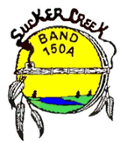Sucker Creek First Nation facts for kids
 |
|
| People | Cree |
|---|---|
| Treaty | Treaty 8 |
| Headquarters | Enilda |
| Province | Alberta |
| Land | |
| Reserve(s) | |
| Land area | 59.87 km2 |
| Population (2019) | |
| On reserve | 759 |
| On other land | 38 |
| Off reserve | 2133 |
| Total population | 2930 |
| Government | |
| Chief | Roderick Willier |
| Council size | 6 |
| Tribal Council | |
| Lesser Slave Lake Indian Regional Council | |
| Website | |
| scfn.ca | |
The Sucker Creek First Nation (called Cree: ᓇᒦᐲ ᓰᐲᓯᐢ, namîpî sîpîsis in Cree) is a group of Cree Indigenous people in Canada. They live in a community located near the southwestern shore of Lesser Slave Lake. This area is close to a town called Enilda in Alberta, Canada.
The Sucker Creek First Nation is part of Treaty 8. This is an important agreement made a long time ago between First Nations and the Canadian government. As of March 2003, about 2,099 people were registered members of the band. They have almost 6,000 hectares of land set aside as their reserve.
Contents
Who are the Sucker Creek First Nation?
The Sucker Creek First Nation is a self-governing group. They manage their own community and affairs. They are part of the larger Cree nation, one of the largest Indigenous groups in Canada. Their traditional language is Cree.
Where is Sucker Creek First Nation Located?
Their main community is on the Sucker Creek 150A reserve. This land is found along the southwestern side of Lesser Slave Lake. The lake is a large body of water in northern Alberta. Their headquarters are in Enilda, a small community nearby.
Understanding Treaty 8
Treaty 8 is a historic agreement signed in 1899. It covers a vast area of land in northern Alberta, British Columbia, Saskatchewan, and the Northwest Territories. This treaty set out agreements about land use and rights between the Crown and various First Nations, including the Sucker Creek First Nation.
Important People from Sucker Creek First Nation
Many people from the Sucker Creek First Nation have made important contributions. They have worked in different fields and helped their community and beyond.
- Chief Headman Moostoos: He was an important leader in the history of the First Nation.
- Jessica Johns: She is a talented writer.
- Harold Cardinal: He was a very important leader and author. He worked hard to protect the rights of Indigenous peoples.
- Lorne Cardinal: He is a well-known actor.
- Linsay Willier: She is a model and advocate.

